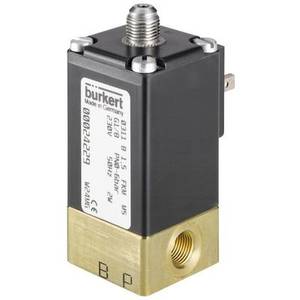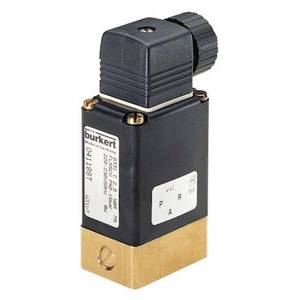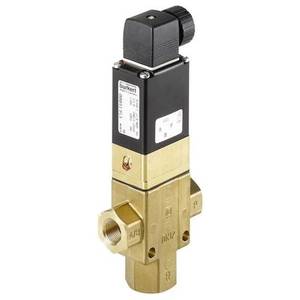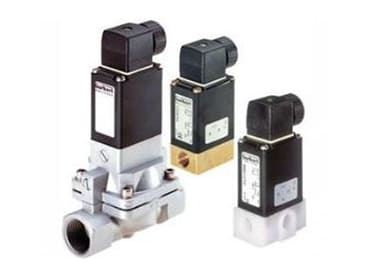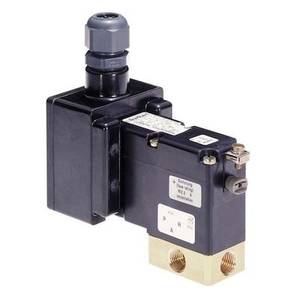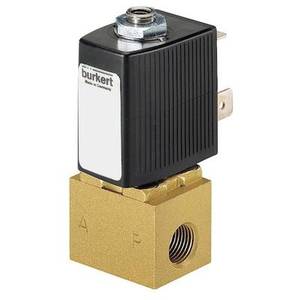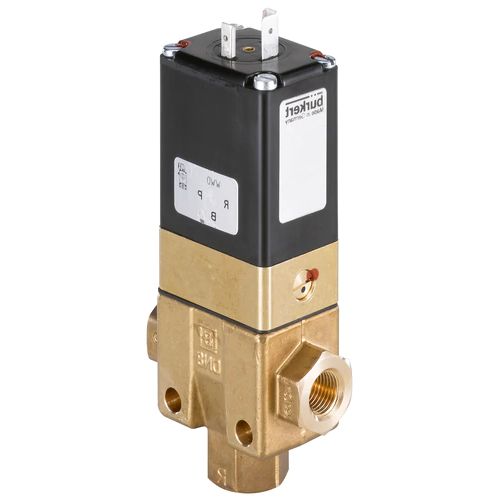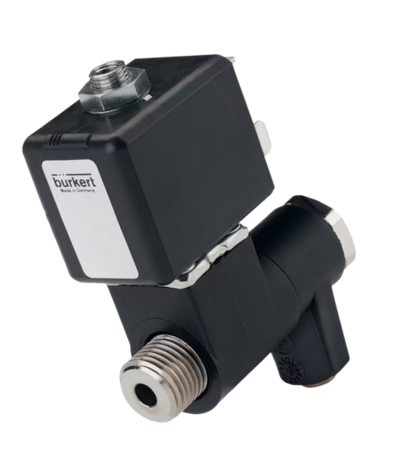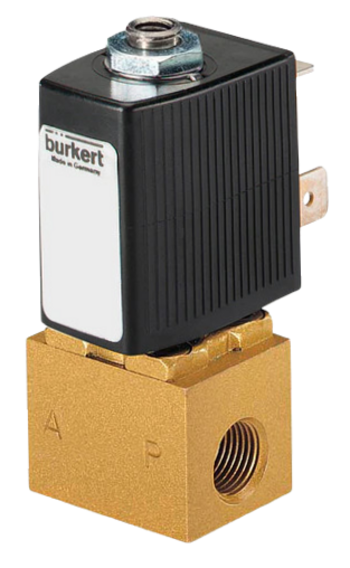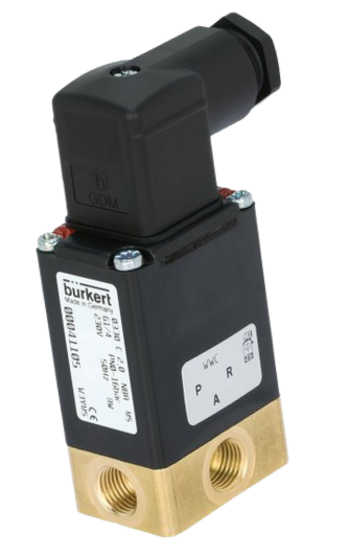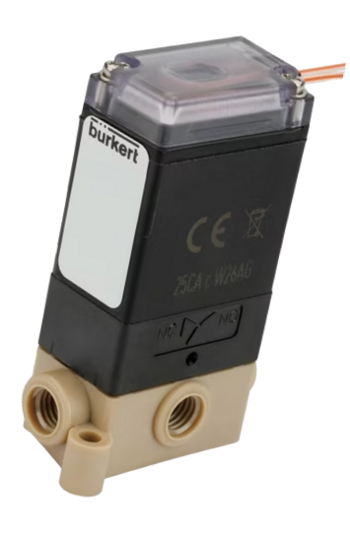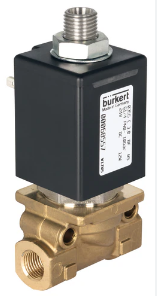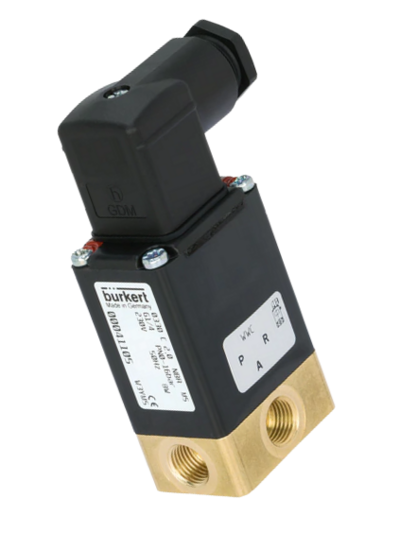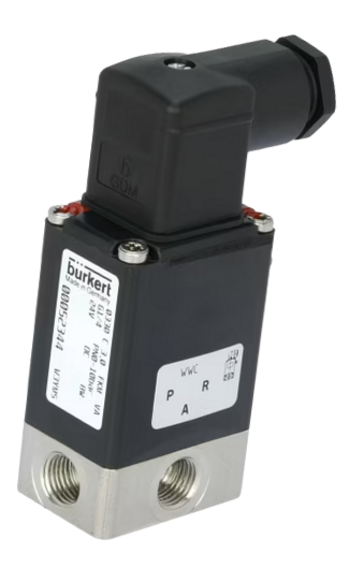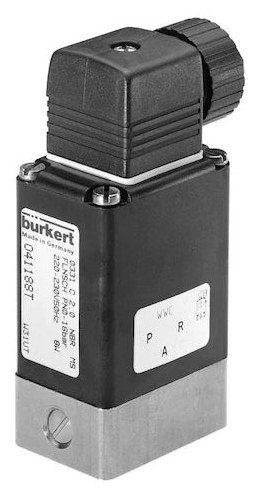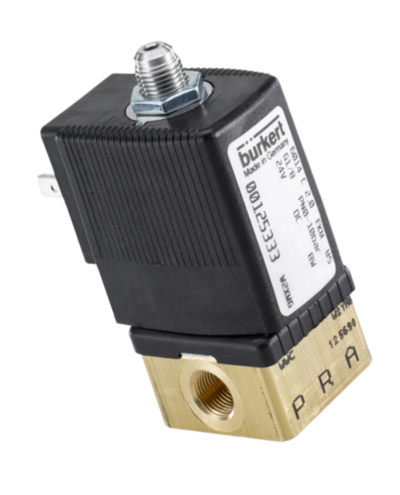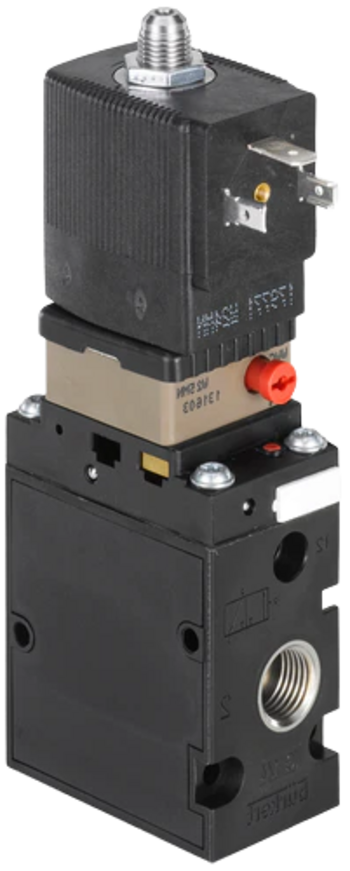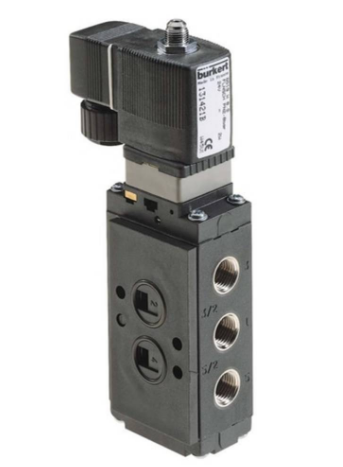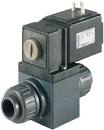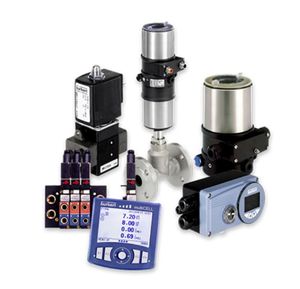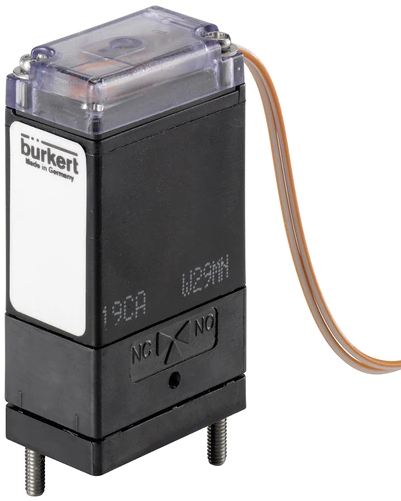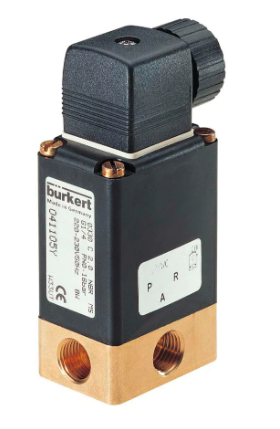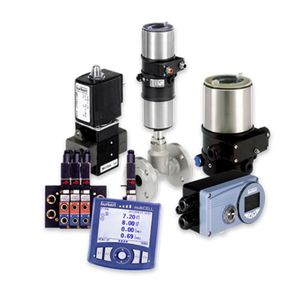Burkert 3-2 Way Valves
IN STOCK!!!
0470-C-04,0-BB-FM01-TA22-024/UC-02 *
Normally open, brass body, suitable for various pneumatic applications.
burkert solenoid valve 24vdc are high-tech devices used to precisely control the flow of liquids and gases in various industrial processes. These valves are characterized by high reliability, durability and a wide range of applications.
The Burkert 0127 direct-acting 2/2 or 3/2 -way solenoid valve is designed for aggressive and clean gases and liquids with low flow rates and pressures from vacuum to 2 bar.
3 2 way solenoid valve are electromechanical devices used to control the flow of fluids (liquids or gases) in various industrial applications.
Valve 0331 is a direct acting pendulum valve with medium isolation.
Available in 2/2-way or 3/2-way.
burkert piston valve
Servo-assisted 3/2-way piston valve
Bürkert 184566 3/2-way pneumatic valve
- Type: 3/2-way
- Diameter: 10 mm
- Operating mode: normally closed
- Material: polyamide (PA)
Burkert 20037306 3/2-way solenoid valve
- Dimensions: diameter 8 mm (3/8 inch)
- Maximum pressure: 16 bar (232 psi)
- Maximum temperature: 150 °C (302 °F)
Burkert 390905 3/2-way solenoid valve
- Type: 3/2-way
- Action: direct
- Type: normally closed (NC)
- Nominal diameter: 1.2 mm (3/64 in.)
Burkert 425285 Solenoid valve
- Valve type: 3/2-way, normally closed (NC)
- Seat diameter: 6 mm
- Connection: G 1/4"
- Pressure: from vacuum to 10 bar
Burkert 43129 3/2-way solenoid valve
- Valve type: 3/2-way (three holes, two operating positions)
- Body: brass (durable and corrosion resistant)
- Sealing: NBR (resistant to many types of liquids and gases)
- Connection: G 1/4" (standard size for industrial and construction applications)
Burkert 464968 3/2-way solenoid valve
- Thread size: G 1/4"
- Power supply voltage: 24 V DC
- Power supply frequency: 50-60 Hz
Burkert 203857 Valve
- 3/2-way
- Normally closed
- high-temperature resistance
- stainless steel body
- PTFE seals
- suitable for compressed air and water
Burkert 20037013 3/2-way solenoid valve
- The valve has a normally closed operating mode
- The nominal pressure is 10 bar
- Nominal flow rate 10 l/min means
- The valve can operate in the temperature range from -20 to +80 °C
Burkert 20037127 3/2-way direct-acting solenoid valve
- Direct action - the valve opens and closes directly under the action of the solenoid.
- Media separated - the solenoid coil is isolated from the medium by a diaphragm.
- Silent - the valve operates silently.
- Robust - the valve is made of high quality materials and has a simple design.
Bürkert 0331 138106 3/2-way solenoid valve
- Valve type: 3/2-way
- Type of action: direct
- Winding voltage: 24 V DC
- Hole diameter: 2 mm
125333 Bürkert 3/2-way direct acting solenoid valve
- Direct action
- Piston and guide tube are welded together
- Valve body made of copper or stainless steel
- Piston group made of polyamide or nickel
Burkert 139163 type 6126 direct-acting solenoid valve
- Type: 3/2-position
- Size: 16 mm
- Purpose: general applications
- Body material: brass
132464 Burkert 3/2-way pneumatic valve
- High flow capacity.
- Reduced power consumption
- Possibility of installation on one or more manifolds. The valve can be installed on one or more manifolds.
3/2 and 5/2-way-pneumatic valve 32 mm
6519-W06,0-GM82-FS05-B5-024/DC-02
3/2-way-pneumatic valve
3/2-way-solenoid valve
3/2-way-solenoid valve for aggressive medium
Type 0127
Electrovanne 3/2 - action directe
3/2 - C - normally closed
Burkert 3/2 Way Valves
Burkert is a world-famous company engaged in the development and manufacture of fluid control systems and components. Burkert valve selection includes various types of models, in particular the 3/2 way solenoid valve, which we will discuss in more detail below.
What Are Burkert 3/2 Way Valves?
The 3/2 way valves are part of Burkert valve technology. The "3/2" designation indicates the number of positions and the number of ports the valve has. In the case of Burkert 3/2 way valves, they typically have three positions and two ports. These devices have three positions, typically labeled as "closed", "open", and a third position that is often a resting or neutral state. The valve can switch between these positions to control the flow of fluid. Also, it has two ports, allowing the control of the flow of a fluid or gas between the ports based on the valve's position. Such valves are commonly used to control the flow of fluids in pneumatic applications.
Applications of Burkert 3/2 Way Valves
Burkert 3/2 way valves find applications in various industries where fluid control is essential. Here are some common applications of these devices.
Pneumatic systems
Burkert 3/2 way valves are often used in pneumatic systems where they control the flow of compressed air. These valves play a crucial role in regulating the movement of pneumatic cylinders, which are widely used in manufacturing processes.
Process control
In industrial settings, the Burkert 3/2-way valve can be employed for process control applications. They can be used to direct the flow of liquids or gases in chemical processing, pharmaceutical manufacturing, and other industries where precise control of fluid movement is necessary.
Automated machinery
These valves are integrated into automated machinery to control the flow of fluids, such as water or air, in manufacturing processes. They contribute to the overall automation and efficiency of the machinery.
Water treatment
Such devices are commonly used in water treatment systems to control the flow of water in various processes, including filtration, purification, and distribution.
Medical and analytical instruments
The 3/2 way valves are utilized in medical and analytical instruments where the precise control of fluids is required. This can include applications in laboratory equipment and medical devices.
Food and beverage processing
In the food and beverage industry, these valves are used to control the flow of liquids and gases in processing and packaging equipment. They help maintain hygiene and ensure accurate dosing of ingredients.
HVAC systems
Burkert 3/2 way valves are used in HVAC systems to regulate the flow of air and other fluids for temperature control and ventilation.
Burkert 3/2 Way Valves in Automotive Industry
In the automotive industry, Burkert 3/2 way valves play a crucial role in controlling the flow of fluids and gases in various applications. They are often used in pneumatic control systems within vehicles and help regulate the flow of compressed air, which can be utilized for functions such as actuating pneumatic cylinders, controlling air brakes, or managing other pneumatic components in the vehicle's systems.
Also, 3/2 way valve can be used in engine management systems. They can control the flow of air or other fluids to optimize engine performance, fuel efficiency, and emissions. Moreover, such devices may be integrated into the transmission systems of vehicles because they can control the flow of hydraulic fluids to engage or disengage different gears and facilitate smooth shifting in automatic or semi-automatic transmissions.
In addition, 3/2-way valves are important components of air brake systems. They help control the flow of compressed air to actuate the brake cylinders, helping to ensure reliable and efficient operation of the vehicle's braking system.
Interestingly, some automotive suspension systems use Burkert 3/2-way valves to control the flow of air or hydraulic fluids, adjusting the stiffness or damping characteristics of the suspension to improve ride comfort and handling. And in emission control systems, such devices can be used to regulate the flow of gases in exhaust systems. This can help meet emission standards by optimizing the combustion process.
Burkert 3/2 Way Valves in Aerospace
Burkert 3/2-way valves can be used in aerospace applications where precise fluid control is required. When it comes to aircraft where hydraulic systems are critical to a variety of functions including landing gear operation, flap movement, and braking systems, 3/2 way valves can be used to control the flow of hydraulic fluids in these systems, providing accurate and reliable operation.
Aerospace applications often include pneumatic systems for functions such as actuating doors, hatches, or valves. Burkert 3/2-way valve can be used to control the compressed air flow in these systems.
It is worth noting that valves play a critical role in controlling the flow of fuel in an aircraft. Thus, 3/2-way valves are used to regulate the flow of fuel or other fluids in fuel systems, which helps improve aircraft efficiency and safety.
Aerospace systems require precise control of air circulation, temperature, and pressure. 3/2-way valves can be integrated into environmental control systems to regulate the flow of air and other HVAC fluids.
In aircraft engines, thrust reversers are used to redirect engine thrust, aiding deceleration during landing. 3/2-way valves can play a role in hydraulic or pneumatic systems associated with these thrust reversers. Burkert valves can also be used in landing gear control systems, helping to control the extension and retraction of landing gear components.
Burkert 3/2 Way Valves in Manufacturing
In manufacturing, Burkert 3/2-way valves can serve a variety of purposes: controlling the flow of fluids, facilitating processes, and increasing automation. Thus, these devices are usually used in pneumatic control systems of production equipment. Valves regulate the flow of compressed air to operate cylinders, control the movement of components, or carry out certain manufacturing processes.
In automated manufacturing processes, 3/2-way valves play a critical role in controlling the flow of liquids or gases. They can be integrated into systems that require precise fluid control for tasks such as dosing, filling, or mixing. Burkert valves can also be used to control the flow of air or other fluids to operate conveyor mechanisms, facilitating the movement of products along a production line.
In packaging equipment 3/2 solenoid valve can be used to control the flow of gases or liquids for applications such as container filling, sealing, or labeling. In addition, such valves play an important role in controlling the flow of fluid in various material handling equipment, such as robotic arms or manipulators. Burkert 3/2-way valves can be used to precisely control the movement of these systems.
Selecting the Right Burkert 3/2 Way Valve
You should consider various factors to ensure optimal performance, reliability, and compatibility with the intended use when selecting a Burkert 3/2 solenoid valve. Here are key considerations.
- Confirm that the 3-2 Way valve types are compatible with the type of fluid (liquid or gas) that will be flowing through it. Consider the chemical composition, viscosity, and any potential contaminants in the fluid.
- Burkert valves come in various materials, including stainless steel, brass, plastic, and others. Choose a material that is corrosion-resistant and suitable for the environmental conditions of the application.
- Ensure that the valve's temperature and pressure ratings align with the conditions in which it will operate. Exceeding these ratings may lead to malfunctions or failure.
- Determine the required flow rate and select a valve size that can accommodate the anticipated volume of fluid. Be mindful of the pipe size and the system's flow dynamics.
- If the valve is a solenoid-operated type, ensure that the electrical specifications, including voltage and power requirements, match the available power source and control system.
- Consider the type of sealing material used in the valve. The seals should be compatible with the fluid and provide a reliable, leak-free seal over the expected operating conditions.
- Understand the specific application requirements. For example, consider whether the valve is needed for on/off control, diverting flow, or mixing fluids. Different valve designs may be more suitable for specific applications.
- Evaluate the response time of the valve, especially if rapid opening or closing is critical for the application. Quick response times are essential in certain automation and control systems.
- Consider the environmental conditions of the application, including ambient temperature, humidity, and exposure to dust or chemicals. Choose a valve that can withstand these conditions.



